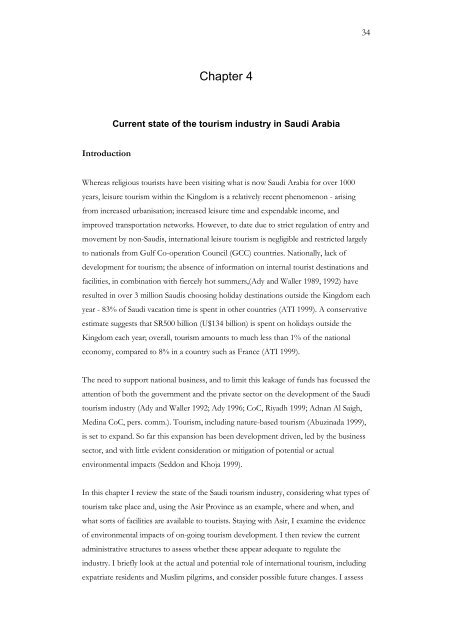The Unfenced Desert Towards a strategy for eco ... - Nwrc.gov.sa
The Unfenced Desert Towards a strategy for eco ... - Nwrc.gov.sa
The Unfenced Desert Towards a strategy for eco ... - Nwrc.gov.sa
You also want an ePaper? Increase the reach of your titles
YUMPU automatically turns print PDFs into web optimized ePapers that Google loves.
Introduction<br />
Chapter 4<br />
Current state of the tourism industry in Saudi Arabia<br />
Whereas religious tourists have been visiting what is now Saudi Arabia <strong>for</strong> over 1000<br />
years, leisure tourism within the Kingdom is a relatively recent phenomenon - arising<br />
from increased urbani<strong>sa</strong>tion; increased leisure time and expendable income, and<br />
improved transportation networks. However, to date due to strict regulation of entry and<br />
movement by non-Saudis, international leisure tourism is negligible and restricted largely<br />
to nationals from Gulf Co-operation Council (GCC) countries. Nationally, lack of<br />
development <strong>for</strong> tourism; the absence of in<strong>for</strong>mation on internal tourist destinations and<br />
facilities, in combination with fiercely hot summers,(Ady and Waller 1989, 1992) have<br />
resulted in over 3 million Saudis choosing holiday destinations outside the Kingdom each<br />
year - 83% of Saudi vacation time is spent in other countries (ATI 1999). A conservative<br />
estimate suggests that SR500 billion (U$134 billion) is spent on holidays outside the<br />
Kingdom each year; overall, tourism amounts to much less than 1% of the national<br />
<strong>eco</strong>nomy, compared to 8% in a country such as France (ATI 1999).<br />
<strong>The</strong> need to support national business, and to limit this leakage of funds has focussed the<br />
attention of both the <strong>gov</strong>ernment and the private sector on the development of the Saudi<br />
tourism industry (Ady and Waller 1992; Ady 1996; CoC, Riyadh 1999; Adnan Al Saigh,<br />
Medina CoC, pers. comm.). Tourism, including nature-based tourism (Abuzinada 1999),<br />
is set to expand. So far this expansion has been development driven, led by the business<br />
sector, and with little evident consideration or mitigation of potential or actual<br />
environmental impacts (Seddon and Khoja 1999).<br />
In this chapter I review the state of the Saudi tourism industry, considering what types of<br />
tourism take place and, using the Asir Province as an example, where and when, and<br />
what sorts of facilities are available to tourists. Staying with Asir, I examine the evidence<br />
of environmental impacts of on-going tourism development. I then review the current<br />
administrative structures to assess whether these appear adequate to regulate the<br />
industry. I briefly look at the actual and potential role of international tourism, including<br />
expatriate residents and Muslim pilgrims, and consider possible future changes. I assess<br />
34

















